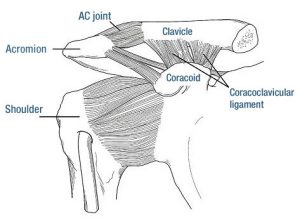
An injury to the acromioclavicular joint is referred to as a shoulder separation.. This refers to the joint on the outer part of the shoulder. The acromioclavicular joint is a horizontal and vertical attachment of the collarbone to the shoulder blade or scapula. This serves to anchor the entire upper extremity to the thorax. This joint is guarded by dense, powerful ligaments that travel from the collarbone to the acromion, a specific projection off the shoulder blade. There are also dense ligaments that go from the collarbone inferiorly down to another projection on the scapula, known as the coracoid. These ligaments guard the joint.

The usual mechanism of injury to the acromioclavicular joint is a fall on the point of the shoulder with the arm held at the side. It can also be injured by an intense body check in hockey or a tackle with the point of the shoulder in football. These types of injuries are very common in athletics. There is usually immediate pain and impairment of function. In the more severe injuries, there may be significant anatomic disruption and a distinctly unusual appearance to the shoulder.
The clinical assessment of acromioclavicular joint injuries is relatively straightforward. The mechanism of injury gives the clinician a distinct hint as to the probable pathology. The patient often points to the AC joint on examination. A high riding collarbone can be easily noted clinically. This can sometimes be confused with the appearance of a dislocated shoulder when the ball has slipped out of the socket. Physical findings which can be used to identify AC joint pathology include the cross body adduction sign which irritates the AC joint. I have also coined the “AC joint ballottement test” where the proximal clavicle is pressed down, and one can visualize the distal clavicle moving more than the opposite, uninjured side. Simple x-rays and physical assessment can rule out the presence of a shoulder dislocation.
Some clinicians use weighted arm views to manifest ligament abnormalities at the joint. This can be done if there is some lack of clarity surrounding the diagnosis. These injuries are graded from 1 to 6, with grades 4, 5 and 6 being very rare manifestations of unusual collarbone placement. The traditional grades are from 1 to 3, where a grade 1 implies ligament irritation only with no significant disruption of joint integrity. A grade 2 injury implies that the ligaments going from both the clavicle to the acromion and the clavicle down to the coracoid have been disrupted and there is some elevation of the collarbone. A grade 3 injury indicates that the ligaments have been more or substantially disrupted and there is an even higher riding clavicle. It is surprising to see how well people can do even though there has been significant anatomic disruption of this joint.
The grade of your shoulder separation is not that important…
The management of AC joint injuries is also relatively straight forward. A sling or collar and cuff can be used for comfort. Ice applied to the joint is generally very helpful. Topical anti-inflammatory agents can also decrease pain and swelling over the tip of the shoulder. Individuals can begin range of motion exercises as soon as possible as the treatment is not intended to heal the ligaments in a normal anatomic position. Circular exercises referred to as Codman or circumduction exercises can be begun immediately. Typically, trying to retract the scapulae helps to minimize AC joint pain.
Most young people recover completely. In the acute phase, there is often what I refer to as a rotator cuff concussion. Because of the proximity of the rotator cuff to the AC joint, there is often weakness of the rotator cuff which leads to impairment of shoulder function for a week or two. Later in life , patient’s may have difficulties with arthritic change at the acromioclavicular joint. This abnormality of anatomic function can again cause difficulties for the rotator cuff which travels directly under the AC joint.
In general, AC joint injuries do well …especially in the short term.
Shoulder separations usually do quite well in the short term…
